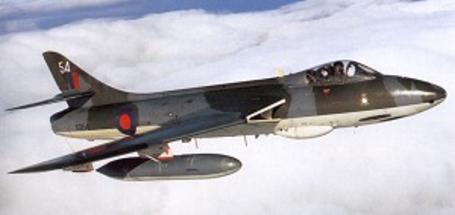Gallery No 15 - Hawker Hunter
Aircraft - 4 Images
My thanks to Roger Dunn and the MOD for supplying these images. Wikipedia for the text.
| Development and first flight Camm and his team set to work, and the new design, given the company designation Type 1067, took shape in late 1948. Metal was cut for the first prototypes in late 1949, the first aircraft being finished in July 1951. It was obvious from the outset that this aircraft's sleek lines, swept wings and tail, would promise good performance. Indeed the overall look of the fighter was more aesthetically pleasing than anything previously seen. The new aircraft took shape around some design features necessitated
by the intended equipment for the fighter's role. The radar ranging
units had to be positioned in the nose, meaning the air intakes were
moved to the wing roots. The armament associated with the ranging equipment
was also entirely novel, in both type and arrangement. The future of
fighter armament at this time was unclear, so four 30 mm Aden cannon
were chosen as being likely to fullfil any Govenement requirement, unprecedented
firepower for the day. The cannon were mounted in a single pod in the
forward fuselage, the whole unit being removable. This meant the Hunter
could be re-armed very quickly, as a full pod could be substituted for
the empty one in around a minute by a trained crew. The first flight
of the Hunter, as this aircraft was now named, was on 20th July 1951.
It flew from Boscombe Down with Hawker's new Chief test pilot, Sqn Ldr
Neville Duke, at the controls. Only one Hunter Mk.3 was built, this was WB188, the first prototype Hunter. It was rebuilt with aerodynamic refinements, and a reheated Avon engine. This engine, the Avon RA7R, developed 7,130lb of thrust dry and up to 9,600lb of thrust with the afterburner lit. On 7 September 1953, Sqn Ldr Neville Duke took the Mk.3 to a new World Absolute Speed Record of 727.6 mph, off the Sussex coast at Rustington. On the 19th of the same month, Duke took the aircraft to a new 100 Km closed circuit record of 709.2 mph. This unique aircraft is still in existence, at RAF Cosford aerospace museum. One further version of the Hunter saw service in the RAF, this was the tactical reconnaissance FR 10. This was similar to the FGA 9 except that it had three cameras fitted in the nose along with other specialised equipment for the reconnaissance role. The Hunter FR 10 replaced the Swift FR 5 in service in RAF Germany with No. 2 Squadron in March 1961. These aircraft served until the end of the 1960's and were replaced by various types, such as the Harrier and the Jaguar. |
Some aircraft may appear identical but there are differences which will not be discernible from the image.
(Be patient with loading)
 |
11 Squadron FAW Mk 4 |
 |
41 Squadron FAW 8 |
 |
60 Squadron FAW9 |
 |
Hawker Hunter FR10 - The last type in service
|
(Be patient with loading)